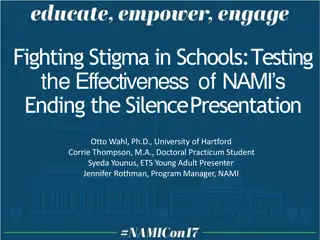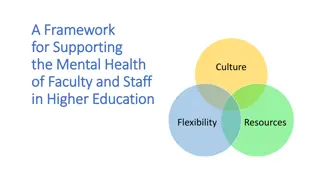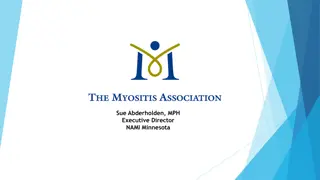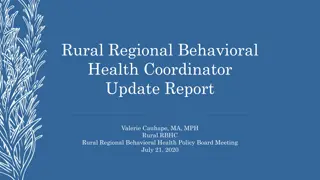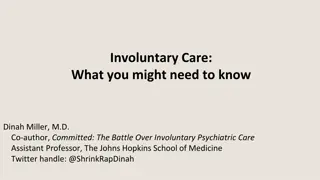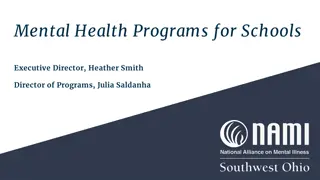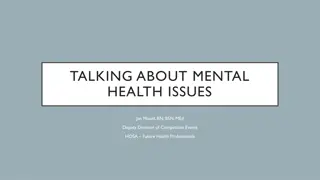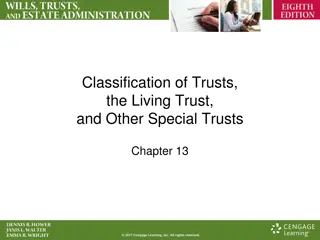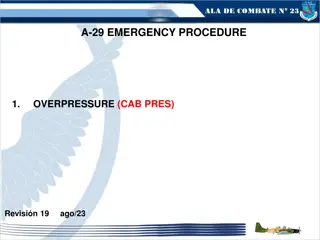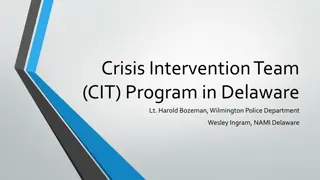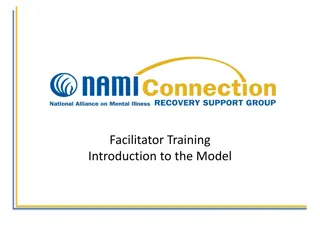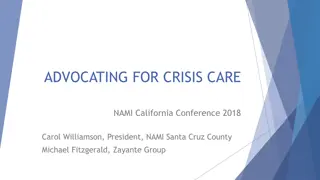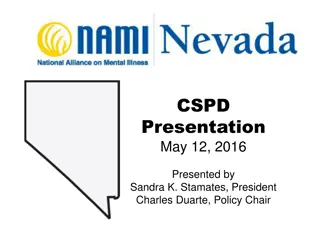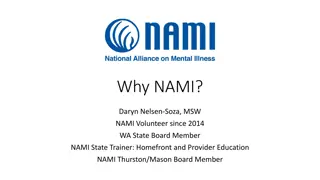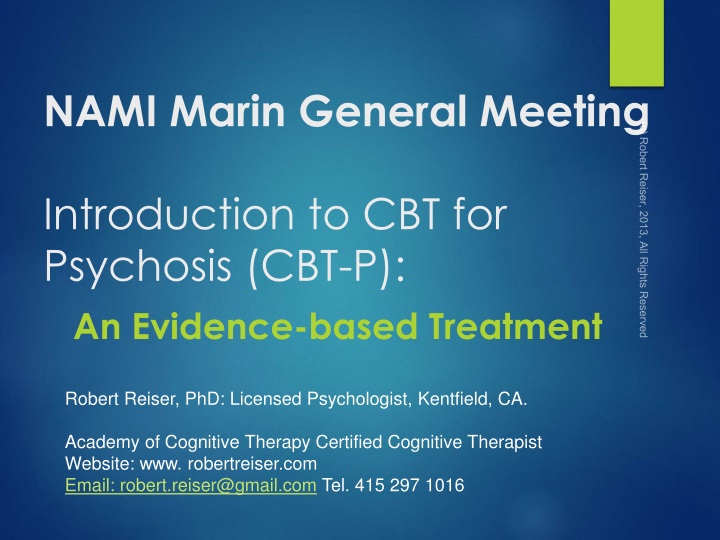
Introduction to Evidence-Based CBT for Psychosis: Transforming Mental Health Care
Explore the evidence-based approach of Cognitive Behavioral Therapy for Psychosis (CBT-P) and its significance in transforming mental health care. Learn about the importance of evidence-based treatment, training issues, and addressing therapeutic nihilism in schizophrenia treatment.
Download Presentation

Please find below an Image/Link to download the presentation.
The content on the website is provided AS IS for your information and personal use only. It may not be sold, licensed, or shared on other websites without obtaining consent from the author. If you encounter any issues during the download, it is possible that the publisher has removed the file from their server.
You are allowed to download the files provided on this website for personal or commercial use, subject to the condition that they are used lawfully. All files are the property of their respective owners.
The content on the website is provided AS IS for your information and personal use only. It may not be sold, licensed, or shared on other websites without obtaining consent from the author.
E N D
Presentation Transcript
NAMI Marin General Meeting Introduction to CBT for Psychosis (CBT-P): An Evidence-based Treatment Robert Reiser, PhD: Licensed Psychologist, Kentfield, CA. Academy of Cognitive Therapy Certified Cognitive Therapist Website: www. robertreiser.com Email: robert.reiser@gmail.com Tel. 415 297 1016
Plan for tonight Introduction Brief review of evidence for CBT-P: Why evidence is important! Reassessing schizophrenia Basic CBT-P techniques with video and examples Training & implementation issues Your questions
Brief review of evidence for CBT-P: Why evidence is important!
The Presidents New Freedom Commission on Mental Health Report: Transforming Mental Health Care in America (Final Report July, 2003) ...(the) mental health field must expand its efforts to develop and test new treatments and practices, to promote awareness of and improve training in evidence-based practices, and to better finance those practices (Page 73)
What is evidence-based treatment ? Evidence-based treatments (EBTs) or empirically-supported treatments are treatments that have been determined to be effective based on research and a gold standard of science. Evidence based practice is defined by the Institute of Medicine: the integration of best-researched evidence and clinical expertise with patient values [Institute of Medicine]
Evidence-based Optimism . the very first step in improving the quality of treatment for schizophrenia is stemming the tide of therapeutic nihilism which still flows far too strongly, with iatrogenic consequences. Evidence- based optimism is one obvious strategy and these guidelines document current evidence-based knowledge and recommendations. Royal Australia and New Zealand College of Physicians guidelines, p8
Some problems pointed out by researchers Therapeutic nihilism, pessimism, past disappointments, errors Over-reliance on a medical model understanding of schizophrenia Divisions between biological and psychosocial approaches Lack of training Lack of resource commitment Lack of a national scheme, plan
Why psychotherapy is important in addition to medicine Pharmacologic therapy can leave as many as 60% of psychotic patients with persistent positive and negative symptoms, even when the patients are compliant with their medication instructions. Furthermore, medication compliance remains a major problem despite the introduction of modern atypical antipsychotics. Studies have shown treatment discontinuation in an estimated 74% of patients in both outpatient and inpatient settings. Taken from: http://www.psychiatrictimes.com/schizophrenia/ abcs-cognitive-behavioral-therapy- schizophrenia/page/0/1
National Institute for Clinical Excellence (NICE) NICE is an independent organisation responsible for providing national guidance on promoting good health and preventing and treating ill health. National Clinical Practice Guideline, Number CG82 (Slides taken directly from NICE guidelines) Retrieved from: http://www.nice.org.uk/
NICE Guidelines- Effective psychosocial treatments* Psychological and psychosocial interventions: Offer cognitive behavioural therapy (CBT) to all people with schizophrenia. This can be started either during the acute phase or later. Offer family intervention to all families of people with schizophrenia who live with or are in close contact with the service user. This can be started either during the acute phase or later. *Nice Guidelines, National Clinical Practice Guideline, Number CG82, update 2009, p.21: www.nice.org.uk
NICE Guidelines- Summary www.nice.org.uk
Delivering psychological interventions, NICE guidelines CBT should be delivered on a one-to-one basis over at least 16 planned sessions and: follow a treatment manual people can establish links between their thoughts, feelings or actions and their current or past symptoms, and/or functioning so that: the re-evaluation of people s perceptions, beliefs or reasoning relates to the target symptoms also include at least one of the following components: people monitoring their own thoughts, feelings or behaviours with respect to their symptoms or recurrence of symptoms promoting alternative ways of coping with the target symptom reducing distress improving functioning.
Family intervention should: include the person with schizophrenia if practical be carried out for between 3 months and 1 year include at least 10 planned sessions take account of the whole family's preference for either single- family intervention or multi-family group intervention take account of the relationship between the main carer and the person with schizophrenia have a specific supportive, educational or treatment function and include negotiated problem solving or crisis management work.
Effectiveness of CBT CBT versus Befriending therapy
Sensky, T., Turkington, D., Kingdon, D., Scott, J., Scott, J.L., Siddle, R., O'Carroll, M., & Barnes, T.R.E. A RANDOMIZED CONTROLLED TRIAL OF COGNITIVE-BEHAVIOURAL THERAPY FOR PERSISTENT SYMPTOMS IN SCHIZOPHRENIA RESISTANT TO MEDICATION. i Archives of General Psychiatry 2000, 57, 165-172. Note: slides 15-24 taken from Turkington, CIMH workshop, May, 2013.
BEFRIENDING Focus on neutral non-threatening topics No active formulation No active techniques taught or used Non-confrontational Non-colluding Empathic Supportive Accepting Note, taken from Turkington, CIMH workshop, May, 2013 (Samarasekera et al, 2007)
Sensky et al. (2000) A randomized controlled trial of cognitive-behavioral therapy for persistent symptoms in schizophrenia resistant to medication. RESULTS: Ninety patients received a mean of 19 individual treatment sessions over 9 months, with no significant between-group differences in treatment duration. Both interventions resulted in significant reductions in positive and negative symptoms and depression. At the 9-month follow-up evaluation, patients who had received cognitive therapy continued to improve, while those in the befriending group did not. These results were not attributable to changes in prescribed medication. CONCLUSION: Cognitive-behavioral therapy is effective in treating negative as well as positive symptoms in schizophrenia resistant to standard antipsychotic drugs, with its efficacy sustained over 9 months of follow-up.
NOTE: BF= befriending; CBT= Cognitive behavioral therapy) DEPRESSION SCORES (Montgomery-Asberg Depression Rating Scale) Cognitive therapy 25 20 15 CBT BF 10 5 0 INITIAL OUTCOME FOLLOW-UP TREATMENT MAIN EFFECT : F(2,176)=46.3; p<0.0001 GROUPxTREATMENT EFFECT : F(2,176)=2.77; p=0.045 Note, taken from Turkington, CIMH workshop, May, 2013
TOTAL SYMPTOM SCORES (Comprehensive psychopathological rating scale) 80 70 60 50 CBT BF 40 30 20 10 0 INITIAL OUTCOME FOLLOW-UP TREATMENT MAIN EFFECT : F(2,176)=45.5; p<0.0001 GROUPxTREATMENT EFFECT : F(2,176)=6.03; p=0.003 Note, taken from Turkington, CIMH workshop, May, 2013
SUICIDAL BELIEFS 2.5 ** p<0.01 2 1.5 CBT BF 1 ** ** 0.5 0 Baseline 9 mths 18 mths Hansen et al, 2007 Note, taken from Turkington, CIMH workshop, May, 2013
CBT versus befriending interventions in schizophrenia resistant to medication on negative symptoms 40 35 S A N S 30 25 CBT Befriending 20 15 10 5 0 Baseline 9mth 18mth 5 yrs SANS Scale for Assessing Negative SymptomsTurkington et al, 2008 Note, taken from Turkington, CIMH workshop, May, 2013
Befriending vs CBT Study Results Positive, negative, and depressive symptoms including suicidal thoughts decreased with CBT Number showing greater than 50% improvement: 63% in CBT group v 39% with befriending (on CPRS) Enduring effect at 5 years Befriending effect on severe persecutory paranoia and none on hallucinations. Note, taken from Turkington, CIMH workshop, May, 2013
Evidence for CBT for Psychosis Note, Slide taken from Turkington, CIMH workshop, May, 2013 Average effect size for target symptom (33 studies) = .40 Average effect size for rigorous RCTs (12 studies) = .22 Significant effects (ranging from .35 .44) for: Positive symptoms (32 studies) Negative symptoms (23 studies) Functioning (15 studies) Mood (13 studies) Social anxiety (2 studies) Wykes et al, 2008 also Pilling et al 2002 & Zimmerman et al 2006 Further evidence of cost effectiveness Peters et al, 2012 Equivalence between CBTP & supportive therapies? Cochrane Review, 2013: Lynch et al, 2009
Current Evidence (psychosis) Note, taken from Turkington, CIMH workshop, May, 2013 Under 16 16-65 Over 65 White Non-White No substance misuse Substance misusers Substance abusers Prodromal Early Persistent Acute wards Community Forensic Meta-analyses/ RCTs None Case studies 1-2 RCTs
Some ineffective or harmful treatments for schizophrenia Psychoanalytic or psychodynamic therapy Therapy based on the double-bind hypothesis of schizophrenia (1970s) Low level, stand alone case management Mega vitamin therapy Other?
Demographics, Risk Factors Social outcome poorer in developed countries High morbidity and mortality rates The excessive mortality of patients with schizophrenia has been reported to be two to four times that of the general population. About 4% 10% of persons with schizophrenia die by suicide, and the rate are highest among males in the early course of the disorder and in industrialized countries. APA Practice Guidelines for the Treatment of Psychiatric Disorders, 2004.
Course of Illness, traditional view The long-term outcome of schizophrenia varies along a continuum between reasonable recovery and total incapacity. About 10% 15% of persons with the disorder are free of further episodes but the majority display exacerbations and remissions in the context of experiencing clinical deterioration, and about 10% 15% remain chronically severely psychotic. APA Practice Guidelines for the Treatment of Psychiatric Disorders, 2004), p.316)
But, how certain are we on the course of schizophrenia The International Study of Schizophrenia (World Health Organization, 2001) provided a long-term follow-up study of 1,633 people diagnosed with schizophrenia. 75% were available for follow-up 50% had a favourable outcome 16% had a delayed recovery after an early unremitting course. Source: A Report From the WHO Collaborative Project, the International Study of Schizophrenia. 2007. Eds. Kim Hopper, Glynn Harrison, Aleksandar Janca, and Norman Sartorius. Oxford: Oxford University Press
Course and prognosis, continued According to the UK s Royal College of Psychiatrists, for every five people who develop schizophrenia: 1 in 5 will get better within five years of their first episode of schizophrenia. 3 in 5 will get better, but will still have some symptoms. They will have times when their symptoms get worse. 1 in 5 will continue to have troublesome symptoms. Taken from: http://www.helpguide.org/mental/schizophrenia_tre atment_support.htm
Recovery From Schizophrenia: An International Perspective (WHO) Heterogeneity of outcome, both in termsof symptoms and functioning, is the signature feature, an observationthat has profound implications for our understanding and managementof the condition. Good outcome was evident in more than 50% of the International Study of Schizophrenia subjects. 60+% of patients found to be recovered (criteria: no long term disability, full time work) Source: Am J Psychiatry 164:1444-1445, September 2007 Book Review. A Report From the WHO Collaborative Project, the International Study of Schizophrenia. 2007. Eds. Kim Hopper, Glynn Harrison, Aleksandar Janca, and Norman Sartorius. Oxford: Oxford University Press.
Outcome-Revisited This 5-year study found that 62% of people at follow-up showed overall improvement on a composite measure of clinical and functional outcomes* * Source: Harvey CA, Jeffreys SE, McNaught AS, Blizard RA, King MB (2007). "The Camden Schizophrenia Surveys III: Five-Year Outcome of a Sample of Individuals From a Prevalence Survey and the Importance of Social Relationships". International Journal of Social Psychiatry 53 (4): 340 35
Predictors of Course of Illness better outcomes are associated, on average, with: female gender, family history of affective disorder, lack of family history of schizophrenia, good premorbid social and academic functioning, higher IQ, APA Practice Guidelines for the Treatment of Psychiatric Disorders, 2004, p. 316.
Predictors of Course of Illness married marital status, later age of onset acute onset with precipitating stress, fewer prior episodes (both number and length), a phasic pattern of episodes and remissions, advancing age, minimal comorbidity, paranoid subtype, and symptoms that are predominantly positive (delusions, hallucinations) and not disorganized (thought disorder, disorganized behavior) or negative (flat affect, alogia, avolition) (APA Practice Guidelines for Treatment of Psychiatric Disorders, 2004, p. 316- 318)
Familial pattern It appears that the course is influenced by cultural factors and societal complexity, with better outcomes in developing countries. (APA, 2004) ~10X risk in first degree biological relatives lifetime risk is 13% for a child with one parent with schizophrenia and 35% 40% for a child with two affected parents (APA Practice Guidelines for Treatment of Psychiatric Disorders, 2004) But Kingdon notes that even in studies of identical twins the rate of concordance is only 36%. (Kingdon, 2005, p.5)
Basic techniques with video and examples
CBT:General approach
CBT, general approach Structured Collaborative Problem oriented Time effective (but not necessarily time limited) Practical-oriented to current problems, improving functioning Uses guided discovery, a non confrontational method for exploring problems, symptoms
Underlying philosophy of treatment People with severe mental disorders can connect deeply with others .can live purposeful, value driven, committed lives The purpose of therapy is to help people live richer, fuller lives, as they define it, in the face of ongoing symptoms and problems Respect limitations: foster realistic hope Taken from: Fowler, D. (2004) San Jose Presentation
Specific Treatment Approach Gentle engagement - start where the person is in terms of their understanding of the illness- avoid jargon Normalizing (but not minimizing distress, symptoms)and educating Destigmatizing illness and instilling hope Start out with guided discovery - a low key conversational exploration of the distressing problems
Setting goals for treatment Client centered Reducing distress and disability is a key goal Target area(s) of functioning affected by symptoms (voices, delusions, negative symptoms) Start with small, manageable goals Encourage willingness and commitment Taken from: Fowler, D San Jose Presentathion
CBT stages of treatment Engaging, developing an alliance Normalizing, remoralizing, destigmatizing III. Developing a collaborative understanding-explaining problems in a more helpful way IV. Helping with distressing and disabling behavior using the ABC model V. Help with distressing beliefs, meanings of the symptoms (hallucinations, delusions) I. II.
Columbo Style Therapist is careful not to make confrontational statements, does not want to contradict the client (avoid confrontation!) Therapist might appear confused or slow- witted, apologizing for not understanding Therapist should then follow client explanations w/questions for clarification & details
Example of CBT: Normalizing, destigmatizing
Exercise: Try to find an explanation for this problem that is normalizing A 16 year old high school junior is afraid to go to school because she is afraid that other people are talking about her. Sometimes she sees other groups of friends laughing and she thinks they might be laughing at her. She feels very anxious and embarrassed.
Using the Vulnerability- Stress Model Illness is produced by a combination of environmental stressors and problematic responses (distress) and innate vulnerability conferred by biology, genes, etc. The message is: We can work on things that are bothering you in a helpful way to reduce distress and disability associated with distress or poor coping skills
Vulnerability-stress model (Kingdon, D., San Jose Presentation, 2004) ILL Decompensate - family attitudes, self-esteem loss of job, home, friends S t r e s s WELL Vulnerability
Example of CBT: Problem-solving, improving coping strategies
EMOTIONS THOUGHTS BEHAVIOR
EMOTIONS: Feel angry, upset attacked. THOUGHTS: The voice is criticizing me again BEHAVIOR: Scream back at the voice And shake my fist




